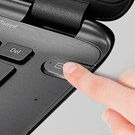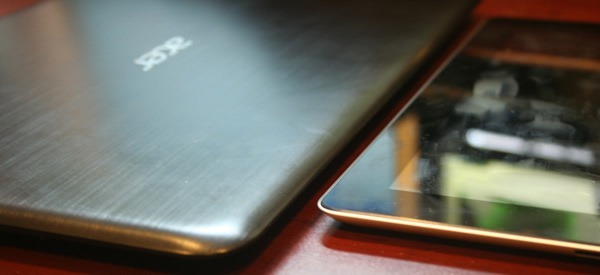More than a few times, I reached into my bag thinking I was pulling out my iPad but instead pulled out the $1,400 Acer Aspire S5 Ultrabook. It’s that thin.
Indeed, at a hair shy of 0.6″ thick, Acer is laying claim to “the world’s thinnest Ultrabook” crown with the S5. That’s technically accurate as far as “Ultrabook” being used as an Intel marketing term goes – you’re free to debate whether the Ultrab0ok-like (but not technically an Ultrabook) MacBook Air‘s variable 0.11-0.68″ thickness is more appealing. If you really want to get into it, Sony released a 0.6″ thick netbook/notebook back in 2009.
Whatever the case, the Aspire S5 is undeniably thin and very light at around 2.65 pounds.

Doug Aamoth / TIME.com
That’s the company’s first step toward trying to convince people that the $1,400 price tag ($1,200 if you know where to look) is worth it. The second step is what’s under the hood. You’ve got a third-generation Intel Core i7 processor, 4GB of RAM and a 256GB solid-state hard drive.
I’d normally half-want, half-expect more RAM for $1,400 but the combination of the processor, solid-state drive and RAM do make for a zippy experience. Startup and resume-from-standby times, especially, are impressive: less than 15 seconds from a cold boot to a usable desktop and a few seconds, more or less, when opening the lid to resume from standby. Portability? Check. Performance? Check. Now on to some of the other goodies.

Acer
In order to keep the computer so slim, Acer has implemented what it calls the MagicFlip I/O port launcher. Pressing a button just to the right of the delete key – which you’ll confuse for the power button at first – raises the machine on its haunches about a quarter of an inch (video here) to reveal two USB 3.0 ports, a full-size HDMI port and a Thunderbolt port.
When these ports are hidden, the only other visible additions to the machine are the power button and memory card reader on the left side, the headphone jack on the right side and the power plug in back. It’s an elegant solution, though the Transformers-like sound when deploying the MagicFlip I/O port launcher may be a bit loud for use in a quiet setting like a library. Be aware, too, that the port launcher will open itself automatically to vent the machine if things run too hot. And things run hot in cramped quarters such as these.

Doug Aamoth / TIME.com
So those are the main things that make the Aspire S5 worth the relatively hefty price – but we’re not done yet. I’ll go out on a short limb and say that any $1,400 laptop nowadays should have a screen resolution of at least 1600×900. The S5 does not. Its 1366×768 screen resolution makes things feel cramped, and worse, the screen’s maximum brightness leaves a lot to be desired. This seems like a case of skimping on the screen to make way for all the other features – arguably advanced features, to be sure; but if you’re looking for pixels and a crisp, sharp screen, your $1,400 can be better spent elsewhere even if it means a little less power and a little more girth.
Battery life is another weak point, which is somewhat understandable given how thin this machine is. Acer rates the three-cell battery as good for “up to 6.5 hours” but I was never able to clear four hours under light to moderate use. Intensive tasks can eat up the battery in half that time, depending what you’re doing. You’ll want to pack the charger if you’re going somewhere for any meaningful amount of time.
Finally, the keyboard and trackpad range from so-so to bad. The island-style keys are a bit spongy, which seems to be a problem with a lot of Ultrabooks – there’s not much travel when machines get this thin. And the trackpad, though decently sized, at times had trouble recognizing when I was holding down the left button and when I wasn’t. The result was intermittent window-dragging and text-selecting when I was simply trying to reposition the cursor. Turning off all the trackpad-specific software options didn’t mitigate the problem any, either. The keyboard I can live with; the trackpad was enough to make me want to tote a mouse around.

Doug Aamoth / TIME.com
If you’re looking for portability and performance, you may find the Aspire S5’s price to be palatable. But anemic battery life, a cheap screen, and a wonky trackpad ultimately hold back an otherwise great machine. The whole getup would be an exponentially easier sell at $999 – and I wouldn’t be surprised to see the price dip that low between now and the end of the year. Unless you absolutely can’t wait, I’d stick it out to see what happens.
And if you can’t wait, at least shop around and see what $1,400 can get you in an Ultrabook from one of the other major players first.
Second Opinions:

